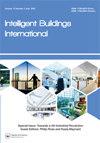A transient thermal sensation equation fit for the modified Stolwijk model
IF 1.7
Q2 CONSTRUCTION & BUILDING TECHNOLOGY
引用次数: 0
Abstract
ABSTRACT There are different thermal perception models linked to a mathematical thermophysiological human model, with which the thermal sensation under stationary and/or dynamic conditions can be evaluated. Each of these perception and thermophysiological models have their own field of application. Stolwijk developed a thermophysiological human model without an associated thermal perception model, which today is still the basis for other mathematical thermophysiological models. Fiala developed the FPC model, also based on the Stolwijk model, and is one of the latest developments in the field of thermophysiological human models. In the FPC model, an equation is included with which the thermal sensation under stationary and dynamic conditions can be assessed; the so-called Dynamic Thermal Sensation (DTS). The DTS equation is, however, specifically developed for use in combination with the FPC model. In contrast to the Stolwijk model, the source code of the computer programs of the later developed thermophysiological human models is not freely available, which limits the use and applicability of the models in practice. It is precise because of the availability of the source code that the Stolwijk model is still used in industry and the research world. The question, therefore, arises: ‘To what extent can a human transient thermal sensation equation be derived, combined with the Stolwijk model, in a similar way to that used for the DTS equation in the FPC model?’.一个适用于修正Stolwijk模型的瞬态热感觉方程
摘要:有不同的热感知模型与数学热生理人体模型相关联,通过该模型可以评估静止和/或动态条件下的热感觉。这些感知和热生理模型中的每一个都有自己的应用领域。Stolwijk开发了一个没有相关热感知模型的热生理人体模型,该模型至今仍是其他数学热生理模型的基础。Fiala在Stolwijk模型的基础上开发了FPC模型,是人体热生理模型领域的最新发展之一。在FPC模型中,包括一个方程,利用该方程可以评估静止和动态条件下的热感;即所谓的动态热感觉(DTS)。然而,DTS方程是专门为与FPC模型结合使用而开发的。与Stolwijk模型相比,后来开发的热生理人体模型的计算机程序的源代码不是免费提供的,这限制了模型在实践中的使用和适用性。正是由于源代码的可用性,Stolwijk模型仍在工业界和研究界使用。因此,问题来了:“以与FPC模型中DTS方程类似的方式,结合Stolwijk模型,可以在多大程度上推导出人类瞬态热感方程?”。
本文章由计算机程序翻译,如有差异,请以英文原文为准。
求助全文
约1分钟内获得全文
求助全文
来源期刊

Intelligent Buildings International
CONSTRUCTION & BUILDING TECHNOLOGY-
CiteScore
4.60
自引率
4.30%
发文量
8
 求助内容:
求助内容: 应助结果提醒方式:
应助结果提醒方式:


